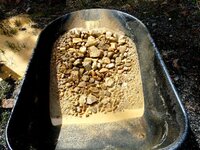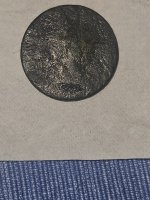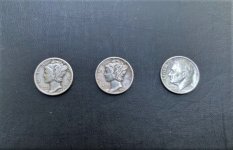burtonridr
Greenie
- Feb 3, 2017
- 18
- 14
- Primary Interest:
- All Treasure Hunting
Hey Everyone, long time lurker here, first post.
I found a location where there is a fair amount of fine gold, by "fine" I'm not sure what I have in terms of classification size, but judging by pictures I've seen, maybe 50 to 100 mesh. The site has a highway between the bench placer and a river, so no way to pump water to the site. I've dug out two buckets worth of material and started worked through it with a small pan in a tub, here is what I've been doing.
Breaking up the clay with my hand, panning out all the light stuff(about 15-20 min). The material I've worked in the past, doesn’t contain clay and so mush black sand, so I can usually work through it faster. But this stuff seems to just take forever and the heavy stuff doesn’t seem to fall to the bottom as easily, it's like I have to work it down a layer at a time. This is the area I would really like to improve and I need help figuring out a way to work through more material. Any suggestions?
Then I've been taking the heavies(lots of black sand) and put them in a soup bowl under a running faucet to further remove material(20-30 min). This part I think I will try building a miller table or something, I think I can cut this time in half.
Then back in the pan before sucking them up into a bottle(10-15min).
This has been working great, I've been getting a great amount of the fine gold in each pan. Problem is the amount of time it takes, and I know I'm losing some of the gold in the process(probably during panning and separating the heavies). I'm only processing 1 pan(small pan) every hour start to finish. I can get 2 pans every 1.5 hours if I don’t watch the black sand in the soup bowl and start a new pan at the same time. I'm looking for ideas to improve the efficiency of my processing a little. My goal is to be able to work through 2 buckets of classified material in a hour or two.
What can I do to remove panning from the process without losing gold or maybe make the process go a little faster? I was hoping to do a recirculating sluice, but I read on here that with the clay it needs a few settling vessels to help keep the water from getting to thick and not allowing the gold to settle out. I don’t know if this is what other have experienced? But, I really don’t want to build the large of a set up to run a few buckets of material. Any thoughts or ideas to look into?
Thanks in advance for the help
I found a location where there is a fair amount of fine gold, by "fine" I'm not sure what I have in terms of classification size, but judging by pictures I've seen, maybe 50 to 100 mesh. The site has a highway between the bench placer and a river, so no way to pump water to the site. I've dug out two buckets worth of material and started worked through it with a small pan in a tub, here is what I've been doing.
Breaking up the clay with my hand, panning out all the light stuff(about 15-20 min). The material I've worked in the past, doesn’t contain clay and so mush black sand, so I can usually work through it faster. But this stuff seems to just take forever and the heavy stuff doesn’t seem to fall to the bottom as easily, it's like I have to work it down a layer at a time. This is the area I would really like to improve and I need help figuring out a way to work through more material. Any suggestions?
Then I've been taking the heavies(lots of black sand) and put them in a soup bowl under a running faucet to further remove material(20-30 min). This part I think I will try building a miller table or something, I think I can cut this time in half.
Then back in the pan before sucking them up into a bottle(10-15min).
This has been working great, I've been getting a great amount of the fine gold in each pan. Problem is the amount of time it takes, and I know I'm losing some of the gold in the process(probably during panning and separating the heavies). I'm only processing 1 pan(small pan) every hour start to finish. I can get 2 pans every 1.5 hours if I don’t watch the black sand in the soup bowl and start a new pan at the same time. I'm looking for ideas to improve the efficiency of my processing a little. My goal is to be able to work through 2 buckets of classified material in a hour or two.
What can I do to remove panning from the process without losing gold or maybe make the process go a little faster? I was hoping to do a recirculating sluice, but I read on here that with the clay it needs a few settling vessels to help keep the water from getting to thick and not allowing the gold to settle out. I don’t know if this is what other have experienced? But, I really don’t want to build the large of a set up to run a few buckets of material. Any thoughts or ideas to look into?
Thanks in advance for the help
Amazon Forum Fav 👍
Upvote
0









